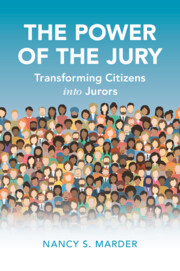Refine search
Actions for selected content:
3 results
21 - Beliefs About Juror Decision-Making and the Jury Process
- from Part III - Trial Phase Decision-Making
-
-
- Book:
- The Cambridge Handbook of Psychology and Legal Decision-Making
- Published online:
- 22 February 2024
- Print publication:
- 29 February 2024, pp 324-338
-
- Chapter
- Export citation
Introduction
-
- Book:
- The Power of the Jury
- Published online:
- 25 August 2022
- Print publication:
- 15 September 2022, pp 1-12
-
- Chapter
- Export citation

The Power of the Jury
- Transforming Citizens into Jurors
-
- Published online:
- 25 August 2022
- Print publication:
- 15 September 2022
